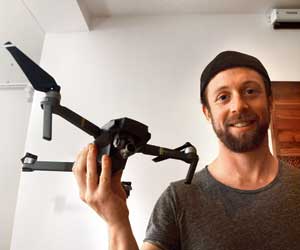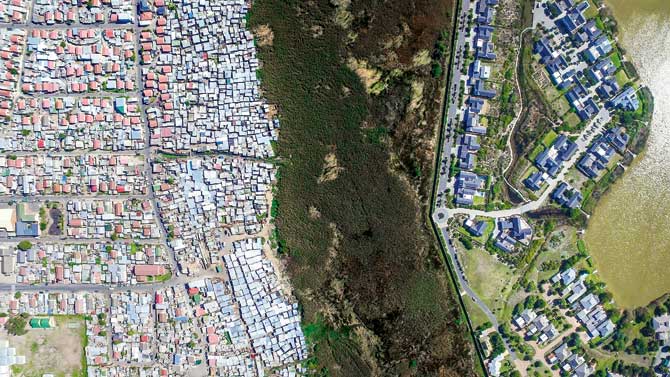Cape Town-based photographer Johnny Miller is using a drone camera to highlight the ground reality of social inequalities in Mumbai and other global cities from the skies above

On an unpleasantly warm Tuesday afternoon, Johnny Miller hit Juhu Chowpatty, made himself as inconspicuous as he could behind a sand mound and flew his drone camera to capture Mumbai from a hitherto unseen viewpoint. Unseen, because in India, flying a drone requires a long line of permissions to come through from the aviation ministry. The US-born and now Cape Town-based photographer managed to clear the ground for himself and secured the required ticks, with the help of a "well-connected friend", to shoot Dharavi, Juhu and Bandra Kurla Complex from above.
ADVERTISEMENT

This was the first photo taken for Unequal Scenes. On the left is Masiphumele in Cape Town, where 38,000 people live in tin shacks; on the right is the wealthy Lake Michelle area. Separating them is a wetland patch.
His project, Unequal Scenes, is a one-of-a-kind photo narrative that captures social discrepancies, from a height of a few hundred metres. Cape Town forms the focus of Miller's work, but his photos also span Nairobi, Mexico City, and the US. In India, Mumbai is his first stop.
It's currently a work in progress, and if all goes well, Miller will exhibit his works here in 2019. Speaking to us before his talk at Colaba's Tarq art gallery, he says that he first visited Mumbai in 2016 for a project where he was expected to capture the world's largest slums. At that time, however, he did not see himself experienced enough to try his luck with the drone here. This time around, he says that getting a drone into the country wasn't easy. "And then, I forgot my charger. I had to get a guy from a street-side shop to work the wires of a charger, so that it worked for my drone!"

Stumbling on a spot to shoot is no accident, he says. "In South Africa, for instance, there are census maps that mark areas as black, white, rich, poor. This helps me narrow in on a potential zone to shoot. I then look them up on Google Earth to get an idea of how they appear from the skies. In India, I have not been able to source such maps, but my research led me to the works of architect PK Das, who worked extensively on the slums of Mumbai. It proved helpful."
Miller says research is imperative to pursue drone photography because, "you can only fly for a limited time and get about 50 shots". "While choosing a spot, I listen to my instincts in various ways, and so far, I have not been disappointed. Today, for instance, I didn't imagine I'd get the shots I did," he smiles. Barring the photography aspect of it, flying a drone requires a gamut of skills. "It's dangerous if you lose concentration and cross a line you should not. And people on ground are always curious about what you are doing. I walked through the slums here in Juhu and Dharavi today, talked to the locals and gauged their reactions. You don't want them on the wrong side. And then, I had to make myself inconspicuous while shooting. That's my modus operandi anywhere. It's part gangsta, part photographer, part journalist."

The 36-year-old however, is no stranger to adventure. Before he found his calling in drone cameras, he was a "drifter, trying out different things", which included a Forrest Gump-esque walk from Mexico to Canada, for no reason at all, when he was 27. After a basic course in documentary videos, a scholarship took him to Cape Town to study anthropology, in 2012. "I fell in love with the place and have stayed back since." To sustain himself, he began to take up freelance photo projects. When he first toggled with the drone, he had no goal in mind. "I just wanted to make an extra buck, by adding an edge to my images. Then one day, I shot a video of myself hiking on the Table Mountain. When a friend saw it, he told me he had never seen Table Mountain from that angle. And he's a local. I realised that the drone has the power of a new perspective. Thereon, my story developed bit by bit, with every shot I took."
Once the government legalises the use of drones in India, come January 1, 2018, Miller believes things will get easier. "When you see poverty or any kind of inequality from top down, it helps you acquire an objective point of view, rather than emotionally engage with an image. My aim is to get a dialogue started, and involve policy makers to address the problem, around the world."
Does he worry that the 'wow' factor of his images might take away from the message? "I am worried about the opposite, in fact. People get the message but shy away from appreciating the art. Because that would mean they are calling slums and shanties beautiful," he laughs.
 Subscribe today by clicking the link and stay updated with the latest news!" Click here!
Subscribe today by clicking the link and stay updated with the latest news!" Click here!






